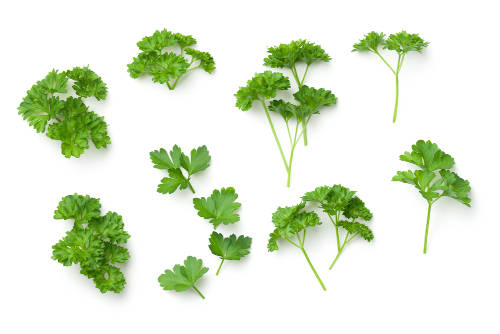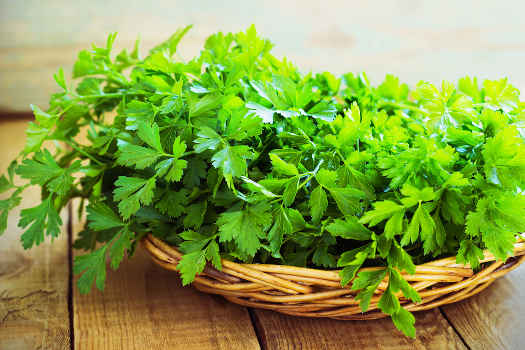Parsley (Petroselinum crispum) is probably best known as the fluffy green used to fill up empty spots on plates. Frequently turned to for its visual appeal, parsley has the distinction of being one of the most popular yet most ignored culinary herbs.
All that aside, people should eat more parsley. Not only does it offer numerous health benefits, it also has a long history of use as a magical herb.
Magical Properties of Parsley
It might be hard to believe, but this green garnish is a bit of a magical powerhouse. It’s most often used to communicate with the spirits of the dead, though some old recipes include it as a spirit repellent.
Parsley is also a protective herb. It got its start as a garnish in ancient Rome, where people would place it on their plates to protect their food from contamination.
Interestingly, this herb is also associated with fertility. Parsley was said to grow best when sown and cultivated by a pregnant woman.
In English folk magic, it was believed that one could strike an enemy dead by plucking parsley while speaking their name.
Parsley is ruled by the planet Mercury and the element of air.
Benefits & Uses
Parsley is surprisingly high in vitamins and minerals, including vitamin A, C, and K, folate, iron, magnesium, and calcium. A quarter cup of chopped parsley also supplies about 2% of the recommended daily allowance of potassium.
This herb contains apigenin, an antioxidant compound. Antioxidants help protect the cells against free radical damage.

While some free radicals are natural, like those produced by digestion and exercise, factors like stress, pollution, and ultraviolet light exposure can produce them in excess.
Parsley is a powerful natural diuretic. Diuretics are substances that trigger the body to produce urine.
Possible Risks & Side Effects
Parsley allergies aren’t common, but they’re possible. These can show up as rashes, trouble breathing, or even anaphylaxis. If you have a reaction to parsley, stop using it and consult a doctor immediately. If you are allergic to parsley or other members of the carrot family, please use a different herb in its place.
That said, parsley can also cause dermatitis when used topically. This isn’t necessarily a true allergy — just a sign of irritation.
Parsley oil contains furocoumarins, which can cause a phototoxic reaction when exposed to sunlight. Phototoxicity may manifest as burns, blistering, and darkening of the skin. For this reason, parsley anointing oils or other topical preparations shouldn’t be used within 48 hours of sun exposure.
This herb is safe when consumed in the amounts you’d use in food. Large amounts may be unsafe, and lead to kidney and liver problems.
Most of the danger of parsley comes from its poisonous look-alikes. Most members of the carrot family strongly resemble each other, which can make identification difficult in the wild.
Poison hemlock (Conium maculatum) and fool’s parsley (Aethusa cynapium) are both members of the same family, and have more than a passing resemblance to true parsley. As their names suggest, they are also poisonous.
Never consume or use a wild plant unless you have a positive identification. It’s often said that you should be as confident about the species of a wild plant as you are about picking up an apple in the produce aisle, and it’s good advice.
History & Folklore
Parsley is native to Europe, where it has an interesting and colorful reputation.
In ancient Greece, parsley seeds were said to have to travel to the underworld and back before they could sprout. Persephone, Queen of the Underworld, was often depicted carrying a sprig of the herb. Parsley was used to decorate tombs, and wreaths of the herb were awarded at the Isthmian and Nemean games.

This belief carried over after the Christianization of Europe, when people claimed that parsley seeds had to visit the devil nine times before they could sprout.
Parsley continued to be associated with death in English folklore. It was said that a field of parsley “will bring a man to his saddle and a woman to her grave,” and parsley appearing in a garden presaged a death before the year was over.
Getting Started With Parsley
Like the stories of parsley traveling to the underworld before sprouting imply, it takes a long time to grow parsley from seed.
Fortunately, it isn’t too difficult. It’s best planted in early spring to midsummer, and enjoys full sun to part shade and moist, well-drained soil. Since parsley is grown for its leaves, it does best in a fairly rich soil. Parsley is also a great herb for growing indoors, in a sunny windowsill.
Germination rates for parsley seeds aren’t great, so it’s a good idea to sow more than you think you’ll need. You can somewhat improve germination by stratifying seeds before sowing. Keep them in the refrigerator for a few weeks, then, when you’re ready to sow, soak them in warm water overnight.
If you’re going to start your parsley indoors, sow them into biodegradable pots. This is one herb that doesn’t enjoy transplanting, so being able to bury the whole pot will go a long way toward reducing stress on your plants.
Magically, one easy way to get started with parsley is in a purification bath. This herb is strongly associated with repelling contamination, which makes it useful for shedding negative or unwanted energies.
To do this, first take a regular bath or shower to ensure that you’re physically clean. Next, fill a reusable tea bag or strainer with dried parsley leaves. Place this in a bowl or mug, and pour boiling water over it.
Allow the parsley to steep while you re-fill the bath with fresh, clean water. Add the parsley tea to the water, and stir it in a counterclockwise direction with your dominant hand.
Ask the parsley for help removing the energies that you don’t want. Step into the bath, and fully immerse yourself. Allow yourself to soak until you feel that you are cleansed and the bath is complete. When you are ready, step out.
If you don’t have access to a tub, that’s okay. You can perform the same bathing ritual by adding the parsley tea to a large bowl or basin of clean water, and pouring it over your head.
If possible, you should dispose of the bathwater by taking it outside and throwing it over your shoulder toward the sun.
Some traditions state that this should be done toward the rising sun, so the negative energy removed by the bathwater can be destroyed by the light. Others hold that it should be done toward the setting sun, so it may disappear when the light does. Do what feels most appropriate to you.
Parsley is often overlooked, and undeservedly so. This herb was once considered a fitting prize for heroic athletes and brilliant poets, as well as a fitting tribute for the dead. It can summon spirits and was believed to end lives, is an excellent source of many important nutrients, and is a wonderful herbal diuretic.
The next time you’re served parsley, take a moment to appreciate its medicinal and magical powers.
